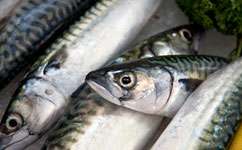Size matters for fish in a changing climate

A changing climate could have a drastic impact on fish populations in the tropics, but according to new research it's likely to boost stocks in some cooler waters.
Although across the globe the total amount fish may not change much under climate change, who gets what probably will. Some continental shelf-sea regions far from the equator could see the amount of fish available to be caught each year increase massively, provided fisheries are managed effectively. But in tropical regions like parts of the eastern Indo-Pacific and the waters west of South America, the availability of fish could fall substantially.
Many millions of people live on fish from coastal and shelf-sea waters, so if the projections are right, the implications for regional food security could be grim. For example, the South Pacific island nation of Palau experienced the greatest loss in 'primary production' - that is, how much sunlight gets turned into living matter by the algae that directly or indirectly feed almost everything else in the ocean. This will directly affect how many fish there are in the sea.
'The Indo-Pacific is a hotspot of global marine biodiversity, and lots of people depend on this biodiversity,' says Dr Julia Blanchard of the University of Sheffield, the paper's lead author. 'And of course it's a region with other serious climate-change-related issues as well.'
She adds that another area of concern, the Humboldt ecosystem to the west of South America, is among the most important in the world for the commercial production of fish meal, which is then used to feed farmed fish. So a consistent decrease in the productivity of fish here could have wide-reaching economic consequences. She cautions that more research is needed. 'These predictions are highly uncertain because they are based on a climate scenario that may not happen and we have had to make many simplifying assumptions. But it is a first exploration of possible climate change impacts for fisheries in the global coastal ocean.'
The research was part of the Quest-Fish project led by Professor Manuel Barange at Plymouth Marine Laboratory. This brought together a large interdisciplinary team of oceanographers, ecologists and social scientists working to predict the consequences of climate change for marine ecosystems, global fisheries and society.
Previous efforts have tried to model the changing distribution of particular species, but overlooked the important role that tiny algae play in food webs. The difficulty with including detail of every species in a food web is that we lack much of the ecological knowledge required to capture this level of complexity. They decided to concentrate instead on the size of the animals present in these marine ecosystems.
We know that there are more small animals in any environment than big ones - it takes a lot of antelopes to support one lion. This principle holds everywhere, and scientists have understood for a long time that there are fixed mathematical rules that seem to govern the relationships between organisms of different sizes in any ecosystem. These rules especially apply to the ratio of plankton to small fish to big fish to top predators in marine food webs.
By working out how much plankton there will be under the latest IPCC's latest climate-change projections, the scientists could calculate how much energy will be available in the ecosystem to support bigger animals. They then translated this into predicted numbers by representing the way food flows upwards from the tiniest plankton to the biggest predatory fish.
They tested the model by running it for previous years and then comparing the results with average fish catches from different countries over those years. Given the simplicity of their model, the two matched surprisingly closely for many regions. The size-based model's results also agreed surprisingly closely with those of earlier models based on species distributions.
'We weren't expecting our predictions to end up so close to theirs,' Blanchard says. 'There are several plausible ways to model this, so I was pleasantly surprised that such a simple model as ours can produce realistic past catch figures and fish growth rates, at this very large scale and as a first step.'
Blanchard and her collaborators now plan more detailed work testing and comparing the outputs of these different models and to pinpoint the sources of uncertainty in each. She also aims to examine particular geographical areas in detail to understand in depth how reliable model predictions might be for local ecosystems and to figure out what would make them better. For example, the model did not capture the complexity that is important for local ecosystems, such as coral reefs, but the planned follow on research is intended to change that.
The paper appears in Philosophical Transactions of the Royal Society B.
More information: Potential consequences of climate change for primary production and fish production in large marine ecosystems. Phil. Trans. R. Soc. B 5 November 2012 vol. 367 no. 1605 2979-2989. DOI: 10.1098/rstb.2012.0231
Journal information: Philosophical Transactions of the Royal Society B
Provided by PlanetEarth Online
This story is republished courtesy of Planet Earth online, a free, companion website to the award-winning magazine Planet Earth published and funded by the Natural Environment Research Council (NERC).
















